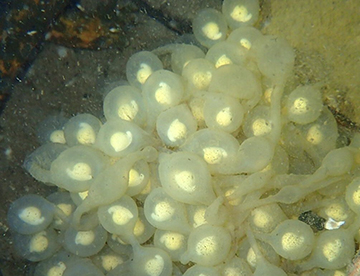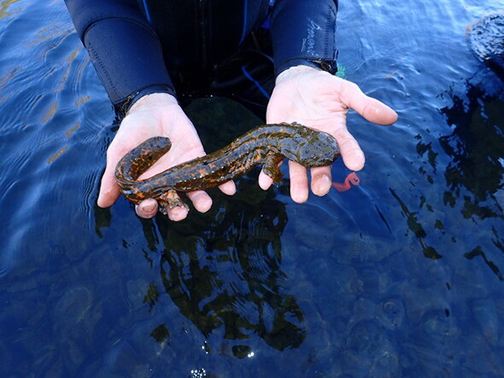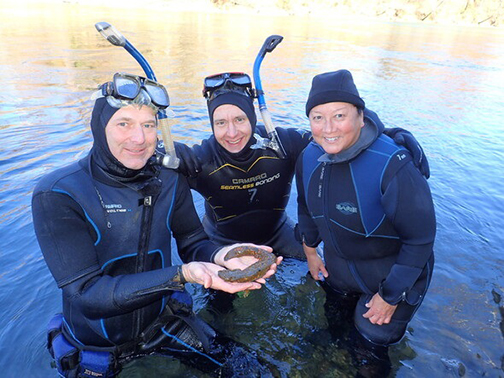JEFFERSON CITY, Mo. – The Missouri Department of Conservation (MDC) announces a significant milestone in population recovery efforts of the endangered Ozark hellbender. A zoo-raised hellbender has successfully reproduced within the Current River.

MDC announces the first zoo-reared Ozark hellbender has successfully fathered a clutch of eggs (pictured) on the Current River. MDC partnered with the Saint Louis Zoo and other agencies to restore threatened hellbender populations to Missouri. All photos courtesy of MDC Herpetologist Jeff Briggler
“We are very excited to announce this news,” said Missouri State Herpetologist Jeff Briggler. “This is the first documented event of a zoo-raised animal fathering a clutch of eggs in the wild.”
Rivers in southern Missouri and adjacent northern Arkansas once supported up to 27,000 Ozark hellbenders. Today, fewer than 1,000 exist in the world – so few that the Ozark hellbender was added to the federal endangered species list in October 2011.
BACKGROUND
Hellbenders are large aquatic salamanders. Missouri is the only state that contains both recognized subspecies of North American hellbenders: the Ozark hellbender and eastern hellbender, both of which are listed as endangered both by the state of Missouri and by the federal government.
The primary threats are habitat alteration and degradation, over-collecting, disease, predation, and degraded water quality. Hellbenders are long-lived (with a 30-year lifespan), slow-to-mature amphibians that seldom venture far within the river.

The first zoo-raised Ozark hellbender to successfully reproduce in the wild pictured above. The animal was raised from a clutch of eggs at the Saint Louis Zoo and released on the Current River in 2019.
Numerous wrinkly folds of skin along the hellbender’s sides provide increased surface area for respiration. Capillaries near the surface of the hellbender’s wrinkly skin absorb oxygen directly from the water. Because the species requires cool, well-oxygenated, clean running water to survive, hellbenders are a major indicator of overall health of a river or stream.
The adult hellbender is one of the largest species of salamanders in North America, with its closest relatives being the giant salamanders of China and Japan, which can reach 5-feet or more in length.
HELLBENDER RESTORATION
MDC partnered with the Ron and Karen Goellner Center for Hellbender Conservation, a part of the Saint Louis Zoo WildCare Institute, and other agencies in the early 2000s to breed the salamanders in captivity and rear eggs collected from the wild in order to combat drastic population declines. Once the captive-bred larvae reached between 3-8 years old, they were released in their native Ozark aquatic ecosystem.

MDC Herpetologist Jeff Briggler (left) holds the first zoo-reared Ozark hellbender to reproduce in the wild. Pictured with Briggler is MDC Ozark District Supervisor John Ackerson (middle) and National Park Service Natural Resource Manager Victoria Grant (right).
Biologists began releasing a few zoo-raised hellbenders in Missouri in 2008, later increasing the number of released animals to 1,000 or more per year beginning in 2012. Since the conception of the breeding and raising of this animal in captivity, more than 10,000 Ozark and eastern hellbenders raised at the Saint Louis Zoo and MDC hatchery have been released into their native rivers.
To help recover this species within the Ozark Highlands, biologists monitor the population status of both wild animals and released animals reared in captivity, as well as locate natural nests within rivers during the fall in order to collect eggs that can be reared and released in the future.
“The majority of the hellbenders existing in the wild and all 10,000-plus released animals have a small chip embedded under their skin with a unique number to allow us to identify the animals in future encounters,” Briggler explained.
Though many have been released to the wild, most hellbenders are only just now becoming mature enough to breed. Because very few nests with eggs are found each year, capturing the event of a male attending a clutch of eggs is a rare event.
“We’re lucky to find 20 nests in the wild a year and finding a tagged father that was raised at the Saint Louis Zoo was like finding a needle in a haystack,” said Briggler. “We have been patiently waiting for this significant achievement to occur.”
In October 2022, biologists found that needle when they came across a tagged male Ozark hellbender that was attending a clutch of healthy, well-developed eggs on the Current River. The animal was attending a clutch of 128 eggs. Upon a later return to the nest, the eggs were beginning the process of hatching with the father protecting them.
“Our ultimate goal was to see the successful reproduction of a zoo-reared animal in the wild,” explained Briggler. “And we’ve now accomplished that goal in our journey to save the unique Ozark salamander.”
FROM EGG TO FATHER
This male Ozark hellbender was collected from a natural nest of eggs in the Current River in the fall of 2013 by MDC and National Park Service staff, then transported to the Saint Louis Zoo where the eggs were hatched and reared.
“We have a dedicated team of hellbender keepers, life-support systems technicians, and veterinary staff who work tirelessly to make sure these animals get the best care possible at the Saint Louis Zoo,” explained Justin Elden, Curator of Herpetology and Aquatics at the Saint Louis Zoo, and Director of the Saint Louis Zoo WildCare Institute Ron and Karen Goellner Center for Hellbender Conservation.
The Saint Louis Zoo has nearly 20 years of experience and expertise in rearing hellbenders and has their care down to an exact science.
“This experience allowed for this animal to flourish for the six years it was reared at the zoo and prepare it for its release to the wild,” said Elden. “Caring for hellbenders through their lives, from tiny eggs to sub-adults, takes a tremendous amount of work, but it’s absolutely worth it knowing we’re aiding in the conservation of wild animals and wild places.”
The animal was released into the Current River in July 2019.
“At the time of release, the male weighed 5.6 ounces (160 grams) and measured 11.8 inches (30 cm),” said Elden. “At the time his nest was discovered in the fall of 2022, he weighed 8.9 ounces (252 grams) and measured 14.4 inches (36.6 cm).”
Based on the hellbender’s size, Briggler noted it was likely the animal’s first year reproducing.
“It was exciting to not only see the growth and healthy appearance of this father after living three years in the wild, but to also see such a healthy animal successfully reproduce,” said Briggler.
Eggs generally hatch in about 45 days, but it can take longer with colder water conditions. Upon hatching, the helpless larvae will slowly grow and develop limbs under the protection of the father for several months. In late winter or early spring, the larvae will venture outside the nesting chamber to disperse into the surrounding river habitat. Larvae will breathe with external gills for a few years before they finally absorb their gills and take on the wrinkly appearance of an adult.
“Finding a zoo-raised Ozark hellbender reproducing in the wild is one of the greatest accomplishments for our Zoo’s WildCare Institute conservation efforts and we are incredibly proud to be partnered with MDC on saving this species,” said Elden.
In addition to the Saint Louis Zoo, MDC partnered with the National Park Service, U.S. Fish and Wildlife Service, U.S. Forest Service, and the Arkansas Game and Fish Commission to enhance propagation efforts to ensure hellbenders remain a part of Missouri’s biodiversity.
“It is our hope that such wild breeding events by zoo-reared hellbenders will increasingly become more common as more released animals become mature,” noted Briggler.
To learn more about hellbenders, visit MDC’s online Field Guide at https://short.mdc.mo.gov/4M9
Learn more about the Saint Louis Zoo WildCare Institute Ron and Karen Goellner Center for Hellbender Conservation online at https://short.mdc.mo.gov/4MC
